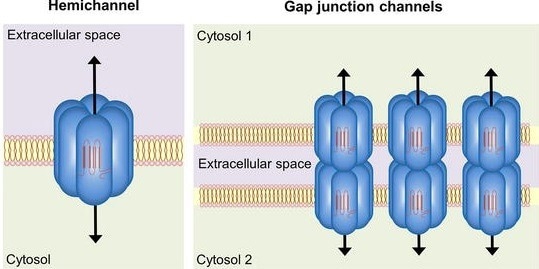One of the epilepsy types that are most prevalent worldwide is temporal lobe epilepsy (TLE). Although there are symptomatic medications available, one-third of TLE patients are still not responding to the current course of treatment, necessitating the urgent need for new drug targets.
 Figure 1: Illustration of hemichannel and gap junction. Image Credit: source: Juan A. Orellana, Synaptic Functions of Astroglial Hemichannels, DOI: 10.5772/intechopen.87142. https://www.intechopen.com/chapters/67921
Figure 1: Illustration of hemichannel and gap junction. Image Credit: source: Juan A. Orellana, Synaptic Functions of Astroglial Hemichannels, DOI: 10.5772/intechopen.87142. https://www.intechopen.com/chapters/67921
Earlier this year, a research team led by a neuroscientist from the City University of Hong Kong (CityU) discovered and created a new drug candidate that has the potential to treat TLE successfully by suppressing neuroinflammation.
Recurrent and spontaneous seizures are a hallmark of epilepsy, one of the most common chronic brain disorders. The majority of anti-epileptic medications currently on the market focus on brain synapses and neurons. Although this treatment is successful in altering neural circuits and synapses, it ignores neuroinflammation, a significant pathology.
Reactive glial cells like astrocytes and microglia that function improperly in the brain can lead to neuroinflammation, which is the result of an immune response. Growing evidence suggests that connexin-based hemichannels and gap junctions in brain glial cells play a significant role in TLE.
A hemichannel, which is a channel or pathway created by the combination of six proteins, allows the release of small molecules from astrocytes and microglia into extracellular space. When the hemichannels of two adjacent cells dock with one another, a gap junction is created.
The fact that gap junctions coordinate the physiological functions of cell assemblies, however, means that inhibiting both hemichannels and gap junctions can have unfavorable side effects. Therefore, to effectively and with fewer side effects reduce neuroinflammation, researchers need to find a way to block only connexin hemichannels.
A new, small organic molecule known as D4 has been discovered by a research team co-led by Dr Geoffrey Lau Chun-yue, Assistant Professor in the Department of Neuroscience. D4 selectively blocks connexin hemichannels but not gap junctions.
Using a mouse model, the team looked into its effectiveness in treating TLE. The results indicate that D4 significantly reduces TLE-induced neuroinflammation, stops TLE seizures, and improves animal survival.
The research was published under the title “Inhibition of connexin hemichannels alleviates neuroinflammation and hyperexcitability in temporal lobe epilepsy” in the international journal Proceedings of the National Academy of Sciences of the United States of America (PNAS).
New drug D4 suppresses neuroinflammation
These are very exciting and encouraging results for translational research in epilepsy. We have found a very promising new drug candidate for treating epilepsy that works through a new mechanism—blocking connexin hemichannels. Our findings also highlight the important involvement of neuroinflammation in neurological disorders such as epilepsy.”
Dr Geoffrey Lau Chun-yue, Assistant Professor, Department of Neuroscience, City University of Hong Kong
The connexin hemichannels in glial cells are the target of the novel drug D4, which targets a new class of ion channels. Astrocytes and microglia are examples of glial cells, which are crucial for controlling neurotransmission.
Through hemichannels, excessive glutamate and other molecules can escape from reactive glia and enter the extracellular environment, changing synapses, promoting neuroinflammation, and worsening seizures.
The team led by Dr Lau is able to directly target neuroinflammation brought on by astrocytes and microglia by specifically blocking connexin hemichannels using D4.
The study used the well-known pilocarpine model of epilepsy in mice, which results in phenotypes that resemble human TLE. To cause seizures, mice were intraperitoneally injected with pilocarpine. Before inducing seizures, one oral dose of D4 effectively reduced neuroinflammation and changed synaptic inhibition, increasing the survival rate of the animal.
A single dose of D4 for the treatment of induced seizures had a protracted effect on reducing astrocyte and microglial activation. This suggests that D4 has a long-lasting effect and significantly reduces neuroinflammation.
A single dose offers long-term benefits
The targeting of connexin hemichannels by D4 is a successful and promising strategy for treating epilepsy in which neuroinflammation plays a crucial role, according to results from both pre-and post-treatment studies.
To effectively reduce the negative effects of neuroinflammation, the medication can be taken orally. A single dose offers effective defense against additional seizures.
Dr Lau added, “We hope that this will ultimately result in new and better treatment options for epileptic patients.”
The group will carry on researching new therapeutic targets and astrocytic mechanisms of epilepsy.
Source:
Journal reference:
Guo, A., et al. (2022) Inhibition of connexin hemichannels alleviates neuroinflammation and hyperexcitability in temporal lobe epilepsy. Proceedings of the National Academy of Sciences. doi.org/10.1073/pnas.2213162119